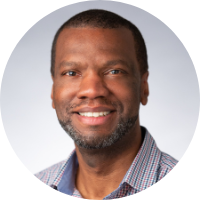
In 2017, you decided to step away from doing science to lead the US R&D Early Talent Programs and head GSK’s diversity recruitment initiative for the US Pharma R&D business. What led to that decision on your part?
That is a great question and one that I get often. Although 2017 was the point that I officially stepped away from doing science, my journey to a career beyond the bench had already started as I was splitting my time between leading science and driving diversity and outreach efforts for the US chemistry community.
I was fortunate that my manager was not only supportive but expected that my time commitment outside the lab as an Employee Resource Group (ERG) leader and Inclusion Council representative delivered impact to the organization. So, looking back it was a natural progression for me to pivot beyond the bench when the right development opportunity presented itself. And leading Early Talent programs and the university diversity outreach initiative were the right opportunities. The role provided me the ability to scale inclusion and diversity initiatives across Pharma R&D and the accountability to do it.
Did you make a proactive decision to pursue a career outside the lab, or did an opportunity present itself?
As I alluded to in the above answer, the opportunity presented itself to me and more importantly, the stars were aligned. My manager and I had a career development conversation about a month before the opportunity presented itself. And in the conversation, we discussed maximizing my potential as either (1) a science leader or (2) as he stated a “bridge builder”. He stated that you are great at both, but one day you may have to choose between the two to reach your full potential. Little did we know what he was foreshadowing as the opportunity presented itself within a month.
What were your priorities as you assessed the various non-traditional career opportunities available to you?
When making the decision to leave the lab and pursue the opportunity in Human Resources, I had two competing priorities. In my current role, I had the flexibility to do both science and drive inclusion and diversity (i.e. the best of both worlds). And in the new HR role, I would have the opportunity to drive change at the institutional level but would require giving up my passion for doing science. To be honest, it was a tough internal struggle. Which passion do I follow?
Was this a rational, logical decision, or did your gut just tell you this was the right answer?
It was definitely a rational, logical decision. The new HR role was structured as an 18-month development opportunity through what GSK calls a secondment (i.e. job rotation) and at the end of the secondment, you can return to your home department. With the security that I could return to chemistry, the stars were aligned as mentioned above.
Personally, I had creditability in science community, manager support, there was a business need, and my efforts in the business was known in HR. In the end, my fear and hesitation of not having complete satisfaction in my day-to-day actions and accountabilities were short-lived. The role was perfect for the next chapter in my career.
In what ways, either directly or indirectly, does your non-traditional career make use of your previous scientific training?
The critical thinking skills developed in a scientific training program are transferrable and leveraged daily. Often, the decisions to make require balancing the pros and cons of many different competing factors and thinking about those decisions scientifically are critical. Another transferrable skill that I utilize is data analysis of complex data sets for insights. Leveraging data to make a more informed decision or prediction is powerful regardless of the type of dataset.
Looking back, how would you assess the performance of your university in making you aware of non-traditional career opportunities? What might it do differently?
This may be an unbalanced question directed toward the performance of the university since I was singularly focused on a traditional scientific career and maybe would not have appreciated alternative career options. However, I do believe universities can do more overall to increase the awareness of the different career opportunities afforded with a STEM degree. In my current role, I meet many students who are not aware of the various career opportunities afforded to them with a science background. As such, an awareness campaign must include both traditional and non-traditional career options. The awareness initiative should incorporate curriculum to expose students to individuals from different types of employers and professions.
Widening the lens a bit, would you expect opportunities in non-traditional chemistry careers to expand, contract, or maintain in the future? What leads you to think that way?
I believe the opportunities in non-traditional chemistry careers will expand. Research shows that diversity of thought positively contributes to the bottom-line performance of companies. What better way to infuse diversity of thought into the discussion than proactively seeking individuals with a different background? Clearly, the lived experience of a scientists brings in a unique and valuable view into discussions.
In your role as Inclusion and Diversity Lead at GSK, how would you assess, generally, the state of diversity and inclusion in chemistry today? Where are the greatest opportunities for progress?
Great question. There is definitely an increased awareness on the need to improve diversity and inclusion in the field. However, many key indicators of achievement (i.e. advanced degrees, prestigious award winners, middle and senior management, etc.) continue to highlight the lack of representation of ethnic minorities and females and thus emphasizes more targeted actions are needed. We must start with increasing the number of ethnic minorities studying chemistry and achieving advanced degrees. It is not only important to increase the number of diverse individuals but also to create an inclusive environment throughout their educational journey and in the workplace, both underpinned by support and mentoring.
A second opportunity for progression is in the career advancement and recognition of female chemists. The chemistry field has made tremendous progress in increasing the number of female scientists; however, their representation in leadership positions across industries lag their overall population. Leaders must acknowledge and avoid the bias practices and traditional ways of working that systematically have hindered the progression of female leaders.
As the 2022 Chair of the ACS Organic Chemistry Division, what are some opportunities you think the division should pursue?
One benefit of the Covid pandemic was the shift to a virtual world and as a result more individuals engaged the division and our many resources. As the division returns to face-to-face meetings, we must continue to leverage the benefits of a virtual world and identify opportunities to continue to expand the reach of the division to underserved communities. Specifically, a formal mentoring program is another opportunity that the Division should pursue as mentoring would benefit chemists of all ages.
How would you assess the state of volunteerism today? Will organizations like the ACS continue to have access to a steady supply of volunteers to drive it forward? Is there something ACS should do to make itself more attractive to volunteers?
This is an interesting question as I believe there will always be a cohort of individuals who are driven to give back. Volunteering for organizations like ACS provides the opportunity to have a positive impact on society. So yes, I think ACS will continue to have volunteers to drive it forward.
Conversely, I do believe there will be a challenge in maintaining the broader membership and it relates to your question regarding attractiveness. I believe individuals are and will continue to ask the question “What is the benefit for me in joining an organization like ACS?” At this time, I don’t have any specific suggestions for things to do. But in general, the ACS must adapt to the changing needs of the chemistry community as the “benefits” over the last two or three decades likely no longer resonant with the current and future membership.
If you could select a total of three scientists/business leaders – deceased or alive – to support you on the project of your choice, what project would you pick, and who you would you put on the team?
Of course, the project would tie together my love for science and my passion to create a more inclusive and diverse community. So the project would be the creation of a top leading cutting-edge research institution dedicated to the training of underrepresented ethnic minorities. Three scientists/business leaders: Dr. Bobby Wilson – lifelong mentor and Professor at Texas Southern University; Dr. Louis Sullivan, Founder of Morehouse School of Medicine, and Ken Frazier, former -CEO of Merck.

Lamont Terrell graduated salutatorian from Texas Southern University as a Fredrick Douglas honor scholar earning a B.S degree in chemistry in 1995. While at TSU, his life as a research scientist began doing undergraduate research focusing on the synthesis of inorganic compounds with environmental applications. He earned his Ph.D. in 2001 in organic chemistry from Michigan State.
His graduate studies consisted of the total synthesis of the antiluekemic natural product amphidinolide A and the development of catalytic tin hydride reactions. Upon completion of his graduate studies at MSU, he continued his synthetic training with a two-year postdoctoral stint at Stanford University. The focus of his postdoctoral studies was the development of a catalytic dinuclear zinc asymmetric Mannich reaction.
In 2003, he began his career in drug discovery as a medicinal chemist at GlaxoSmithKline in their cardiovascular medicinal chemistry group. He spent 11 years doing small molecule lead optimization primarily focusing on cardiovascular disease targets. In 2014, Lamont joined the Flexible Discovery Unit Medicinal Chemistry Center of Excellence as a Team Leader to support late-stage high priority projects in reaching their drug discovery milestones.
Outside of leading science, Lamont is passionately involved with community and outreach efforts. He led the GSK chemistry recruitment team for minority conferences and served as the lead for the African American Alliance employee resource group in the Delaware Valley. This passion led to a career pivot and eventually to his role as the Inclusion and Diversity Lead for R&D. He is responsible for developing and implementing the Inclusion & Diversity strategy for the global business.
The opinions expressed in this article are the author's own and do not necessarily reflect the view of their employer or the American Chemical Society.





